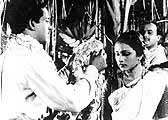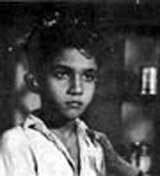Jeevithanouka (The boat of life)
Jeevithanouka (1951) was a
turning point for Malayalam cinema. This highly dramatic musical
film, which narrated the story of ego clashes in a joint family,
was mainly directed towards the women audience. Jeevithanouka
was a huge success, and can be considered as the first "super
hit" of Malayalam cinema. Thikkurishi Sukumaran Nair, an actor
from the stage, became the first "superstar" after the success
of Jeevithanouka. But this success had also an adverse
effect. Films that were made after this film, were channelled
through this success formula, and nothing creative was seen for
a long time. Superstars took over the drivers seat and directors
were forced to the background.
Neelakuyil

Through Neelakuyil
(1954) Malayalam cinema for the first time had an authentic
Malayalam story. The story for Neelakuyil was penned by
renowned Malayalam writer Uroob and directed by the duo of
P.Bhaskaran and Ramu Karyat. This melodramatic film dealt with
the issue of untouchability in the society. Satyan and Miss
Kumari were elevated to stardom after the huge success of this
film. Malayalam film music, which till then was cheap imitations
of Hindi and Tamil film music, also got a fresh breath through
this film. The lyrics written by P.Bhaskaran were arranged by
K.Rghavan in an authentic Malayalam manner. The tunes of this
film, which was influenced by Malayalam folk music, became
popular among the masses. This was also the first Malayalam film
to be shoot outdoors. Neelakuyil showed the presence of
Malayalam cinema in Indian film arena.
Newspaper Boy

Newspaper Boy (1955) was
the reflection of neo-realism in cinema, which became popular
all over the world. This film was a result of extreme hard work
by a group of art loving college students. Newspaper Boy
was directed by P.Ramadas, who was totally new to the film
industry and almost all technical works were handled by amateur
students. This film narrates the sad story of a printing press
employee and his family reeling through poverty. He dies of
extreme poverty and illness, which forces his children to stop
their education. His elder son Appu leaves to Madras in search
of a job. Failing to secure a job there, he reaches back to
Kerala and decides to take up the job of newspaper boy. Even
though P.Ramadas failed in exploring the possibilities of the
media of cinema, his out look of the society is appreciable.
|